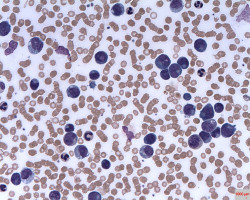
Mariam Ibáñez, lecturer at Universidad Cardenal Herrera CEU (CEU Cardenal Herrera University, UCH-CEU) and biologist at "La Fe" Hospital in Valencia used massive sequencing techniques to identify new recurrent genes mutations involved in the origin of acute myelogenous leukaemia (AML).
She outlines the challenge faced by this study: "The development of AML is associated with the accumulation of acquired genetic alterations in haematopoietic progenitor cells. A study performed by the Cancer Genome Atlas discovered recurrent mutations in 23 genes, with 99% of AML patients carrying at least one of these mutations. However, many patients with normal karyotype carry no mutations in any of these recognised driver genes associated with the origination and development of AML (leukaemogenesis)," she tells us, adding that "despite all our advances, we continue to base our diagnosis of AML on the presence of alterations in just three molecular markers. For patients who do not carry these mutations, the mechanisms that lead to the onset of leukaemia are unknown."
The aim of this study, therefore, was to identify new driver mutations in patients with normal karyotype and none of the three well-established mutations.
The team approached the problem using massive sequencing techniques, analysing nearly a hundred genes in a hundred patients.
Early results did indeed reveal new gene mutations with strong potential to be involved in the pathogenesis of AML in these patients.
Furthermore, by analysing the interactome (the interactions between proteins), they have been able to define a computerised model that simulates the alteration of the leukaemia cell in this type of leukaemia: "In this model, we have grouped the alterations discovered by physical interaction, regulation, function and altered cellular routes."
The team is yet to test this computerised approach against real-life models.
The idea is to deepen existing knowledge on the mechanisms behind leukaemogenesis and, by doing so, be able to optimise the treatment options available to AML patients: "With more information, we would be able to develop more efficient treatments for individual patients that target the specific molecules involved in their AML."
Source: Asociación RUVID